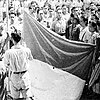
The Indonesian National Revolution, also known as the Indonesian War of Independence, was an armed conflict and diplomatic struggle between the Republic of Indonesia and the Dutch Empire and an internal social revolution during postwar and postcolonial Indonesia. It took place between Indonesia's declaration of independence in 1945 and the Netherlands' transfer of sovereignty over the Dutch East Indies to the Republic of the United States of Indonesia at the end of 1949.

Permesta was a rebel movement in Indonesia that was declared on 2 March 1957 by civil and military leaders in East Indonesia. Initially the center of the movement was in Makassar, which at that time was the capital of the province of Sulawesi. However, support for the movement in South Sulawesi gradually dissipated, forcing the headquarters to move to Manado in North Sulawesi.

The Prime Minister of the Republic of Indonesia was a political office in Indonesia which existed from 1945 until 1966. During this period, the prime minister was in charge of the Cabinet of Indonesia, one of the three branches of government along with the People's Representative Council and the president. Following his 1959 decree, President Sukarno assumed the role and powers of prime minister until his resignation in 1966.
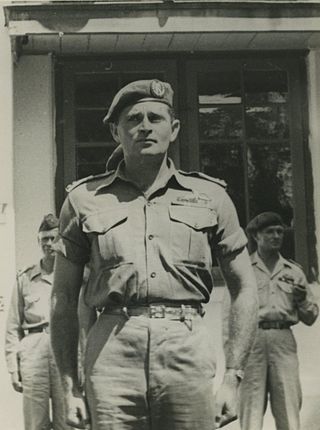
Raymond Pierre Paul Westerling was a Dutch military officer of the Royal Netherlands East Indies Army. He orchestrated a counter-guerrilla operation in Sulawesi during the Indonesian National Revolution after World War II and participated in a coup attempt against the Government of Indonesia in January 1950, a month after the official transfer of sovereignty. Both actions were denounced as war crimes by the Indonesian authorities. Born in the Ottoman Empire, his nickname was The Turk, though Westerling was of Dutch and Greek descent.
The 1949 Federal Constitution of the United States of Indonesia replaced the 1945 Constitution of Indonesia when sovereignty was officially transferred from the Netherlands to Indonesia following the Dutch-Indonesian Round Table Conference. It came into force on 27 December 1949 and was replaced by the Provisional Constitution of 1950 on 17 August 1950.

This is the timeline of Indonesian National Revolution.

The State of East Indonesia was a post–World War II state formed in the eastern half of Dutch East Indies. Established in December 1946, it became part of the United States of Indonesia (USI) in 1949 at the end of the Indonesian National Revolution, and was dissolved in 1950 with the end of the USI. It comprised all the islands to the east of Borneo and of Java.
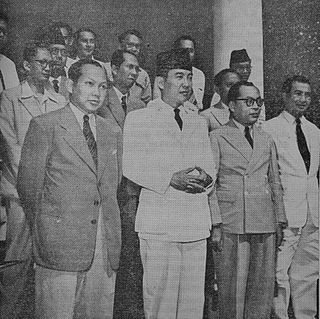
The Republic of the United States of Indonesia Cabinet was established as a result of the formation of the United States of Indonesia following the transfer of sovereignty from the Dutch colonial power. It lasted less than a year before Indonesia became a unitary state.
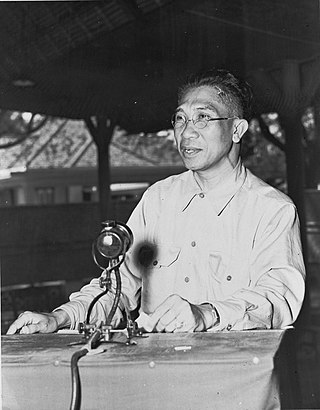
Tjokorda Gde Raka Soekawati, was the only President of the State of East Indonesia from 1946 to its disestablishment in 1950. He served from 1946 until the dissolution of the East Indonesian State in 1950. His title, Tjokorda Gde, signaled that Soekawati belonged to the highest ksatria. He had two wives, the first a Balinese, Gusti Agung Niang Putu, who gave him a son named Tjokorda Ngurah Wim Sukawati. In 1933, he married a French woman named Gilbert Vincent, who gave him two children.

Sultan Hamid II was the 7th Sultan of Pontianak and the only President of the State of West Kalimantan from 1946 to its disestablishment in 1950. He was the eldest son of Sultan Syarif Muhammad Alkadrie. He was of mixed Malay-Arab ancestry and was raised by two British nationals— Salome Catherine Fox and Edith Maud Curteis.

The Legion of the Just Ruler or the Legion of Ratu Adil was a pro-Dutch militia and private army established in the aftermath of the Indonesian National Revolution. It was founded by the former KNIL Captain Raymond Westerling following his demobilisation on 15 January 1949. The militia's name was derived from a passage from the medieval Book of Prophecies of Joyo Boyo which prophesied the coming of a Just Ruler who would be of Turkish descent and come to save the people of Java and establish universal peace and justice. With his mixed Turkish heritage in mind, Westerling used the myth of the Just Ruler to create a following.

The APRA coup d'état was a coup d'état by Raymond Westerling's Legion of the Just Ruler (APRA) to capture Bandung and Jakarta, with the aim to overthrow Sukarno's unitary Republic of Indonesia. Westerling was a demobilised Dutch Captain of the KNIL, who sought to preserve the federal Republic of the United States of Indonesia, which retained the support of the Netherlands and various minority elements. Westerling's forces succeeded in capturing Bandung in the early hours of 23 January 1950.
The South Sulawesi Campaign was a campaign during the Indonesian National Revolution. It was a counter-insurgency offensive of the special forces of the KNIL against Indonesian infiltrations from Java and pro-Indonesian local militias. It was masterminded by the controversial Raymond Westerling, a captain in the KNIL. Westerling's operation, which started in December 1946 and ended in February 1947, succeeded in eliminating the insurgency and undermining local support for the Republicans by instituting summary executions of suspected enemy fighters.
Andi Aziz was a Royal Dutch East Indies Army captain. He was born in Simpangbinangal, Barru, South Sulawesi. He led the 5 April 1950 Makassar Uprising in Sulawesi against the Republic of the United States of Indonesia government. The purpose of the uprising was to revolt against the incorporation of the Indonesian federated "states" into the Indonesian Republic. The uprising was quashed, however, after two weeks when troops under Lt. Col. Suharto and Col. Alexander Evert Kawilarang arrived at Makassar only to find light resistance. Aziz was ordered by the army to return to Jakarta and was promptly arrested on arrival.
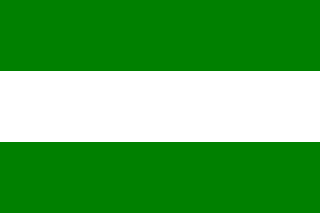
The State of Pasundan was a federal state (negara bagian) formed in the western part of the Indonesian island of Java by the Netherlands in 1948 following the Linggadjati Agreement. It was similar to the geographical area now encompassed by the current provinces of West Java, Banten and Jakarta.

The United States of Indonesia was a short-lived federal state to which the Netherlands formally transferred sovereignty of the Dutch East Indies on 27 December 1949 following the Dutch–Indonesian Round Table Conference. This transfer ended the four-year conflict between Indonesian nationalists and the Netherlands for control of Indonesia. It lasted less than a year, before being replaced by the unitary Republic of Indonesia.

Suharto was the second President of Indonesia, having held the office for 31 years from 1967 following Sukarno's removal until his resignation in 1998.

Andi Abdullah Bau Massepe was a Bugis-Indonesian nobleman who initiated attacks against Dutch forces during the National Revolution. He was the son of Andi Mappanyukki. On 9 November 2005, he was conferred the title of National Hero of Indonesia posthumously.
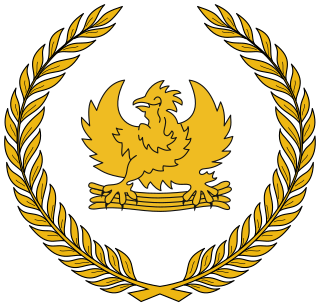
The Cabinet of the State of East Indonesia served as the central government apparatus of the State of East Indonesia, headed by a prime minister who were appointed by the head of state. During the three-year lifetime of the state between 24 December 1946 and 27 December 1949, there were eight cabinets in total, headed by six different prime ministers.
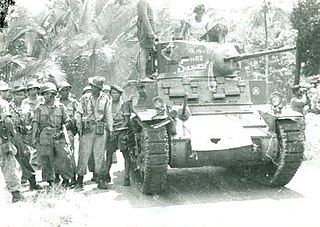
The Invasion of Ambon was a combined Indonesian military operation which aimed to seize and annex the self proclaimed Republic of South Maluku.



















